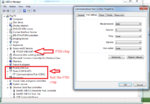pigtwo
Member level 4

Hello all,
I'm working on a project where I need to send data from my computer to an FPGA. I'm using a FTDI chip(FT232RL-REEL) to convert USB to RS232. Sending data from my computer to the FPGA works fine but I'm having some problems with sending data from the FPGA through the FTDI chip to the computer. I can send one byte of data easily with no problems as long I don't send it very frequently. If I start sending data quickly it doesn't work and on my computer I get an error that says "A device attached to the system is not functioning.". The code that generated this error is shown below. I have to disconnect and reconnect the USB cable to get it back into an ok state. I'm thinking maybe there is some sort of control packet it or something I need to give the FTDI chip and maybe it just times out if I don't send the next packet soon enough.
Below is my Verilog for sending RS232 packets:
Here is the code that drives that module to send data quickly:
Here is the code that reads the data on the computer. I'm not a very good programmer and I don't almost anything about USB so this is just copied from the documentation:
Does anyone have experience with this and know what might be causing this? Any help or advice is greatly appreciated!
Thank you!
I'm working on a project where I need to send data from my computer to an FPGA. I'm using a FTDI chip(FT232RL-REEL) to convert USB to RS232. Sending data from my computer to the FPGA works fine but I'm having some problems with sending data from the FPGA through the FTDI chip to the computer. I can send one byte of data easily with no problems as long I don't send it very frequently. If I start sending data quickly it doesn't work and on my computer I get an error that says "A device attached to the system is not functioning.". The code that generated this error is shown below. I have to disconnect and reconnect the USB cable to get it back into an ok state. I'm thinking maybe there is some sort of control packet it or something I need to give the FTDI chip and maybe it just times out if I don't send the next packet soon enough.
Below is my Verilog for sending RS232 packets:
Code Verilog - [expand]
Here is the code that drives that module to send data quickly:
Code Verilog - [expand]
Here is the code that reads the data on the computer. I'm not a very good programmer and I don't almost anything about USB so this is just copied from the documentation:
Code Python - [expand]
Does anyone have experience with this and know what might be causing this? Any help or advice is greatly appreciated!
Thank you!



